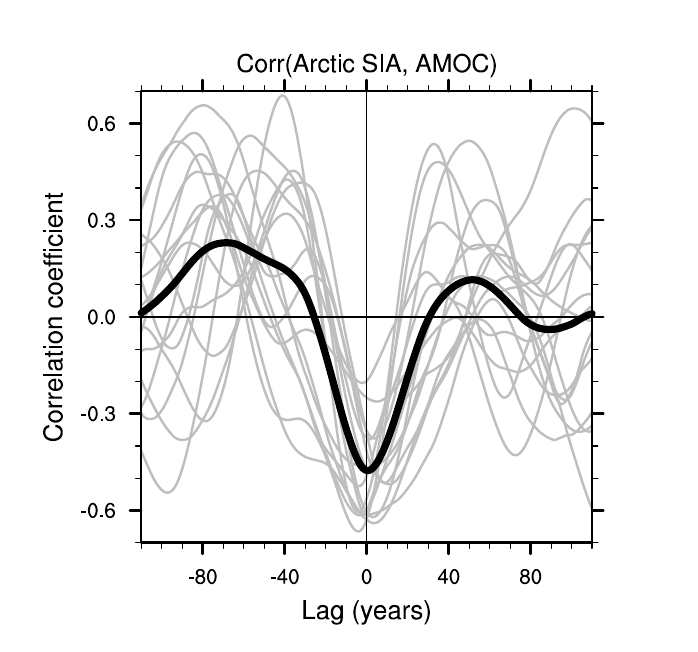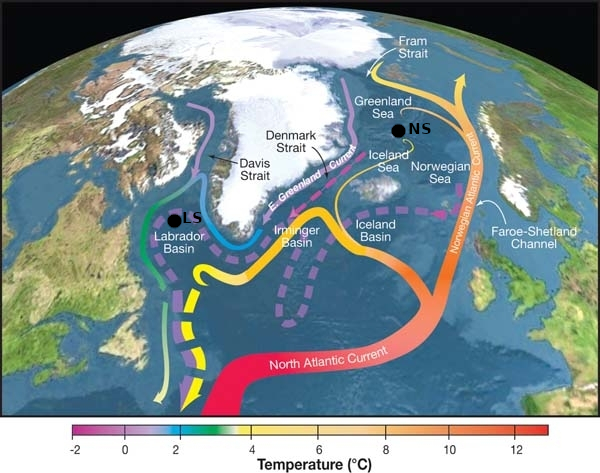On the Arctic Sea Ice and AMOC Relation
The Atlantic Meridional Overturning Circulation (AMOC), is the Atlantic part of the […]
Date Posted:
June 5, 2023
The Atlantic Meridional Overturning Circulation (AMOC), is the Atlantic part of the global thermohaline circulation, which represents the global ocean circulation driven by changes in density, i.e. variations in temperature and salinity of the ocean.
David Docquier wrote for EGU (December 2022), about the connection of the AMOC and Arctic Sea Ice, including the following – for the complete article visit this EGU page.
How can the AMOC affect Arctic sea ice?
The AMOC, by transporting warm water to the North Atlantic, and subsequently to the Arctic, can affect Arctic sea ice. We have seen in a previous post how the heat carried by the Atlantic Ocean has led to strong reductions in Arctic sea-ice area in the past decades. This warm Atlantic water can access the Arctic Ocean either via the Barents Sea Opening (between Norway and Svalbard) or the Fram Strait (between northeast of Greenland and Svalbard) (see Figure 1 of this previous post for the location of the different straits and ocean currents in the Arctic Ocean). This warm water can lead to enhanced melting of Arctic sea ice.
A modeling study carried out by Delworth et al. (2016) shows that a stronger AMOC leads to increased ocean heat transport and reduces the Arctic sea-ice area, while a weaker AMOC results in lower ocean heat transport and increases the Arctic sea-ice area. In another study, Liu et al. (2020) explore the climate impacts of a weakened AMOC using a climate model. This weakened AMOC slows the pace of future Arctic sea-ice loss since less heat reaches the Arctic Ocean.
This influence of the AMOC on Arctic sea ice has also been confirmed in a study involving 16 different climate models (Liu and Fedorov, 2022). Figure 1 below shows the lag correlation between the AMOC and Arctic sea-ice area. A positive lag means that changes in the AMOC lead to changes in sea-ice area, while a negative lag implies that changes in sea-ice area lead to changes in the AMOC. From Figure 1, you can see that the most negative correlation appears when the AMOC leads Arctic sea-ice area by about one year (the black curve represents the multi-model average). This means that a weaker AMOC would lead to a larger sea-ice area after one year via a reduction of ocean heat transport. On the contrary, a stronger AMOC would reduce the Arctic sea-ice area after one year.

How can Arctic sea ice influence the AMOC?
The previous study from Liu and Fedorov (2022) also shows that Arctic sea ice has an influence on the AMOC. If we look again at Figure 1, we can see that the largest positive correlation between the AMOC and Arctic sea-ice area occurs for negative lags, more precisely when sea-ice area leads the AMOC by about 70 years (black curve). This means that a reduced Arctic sea-ice area would lead to a weaker AMOC after about 70 years, while an increased sea-ice area would enhance the AMOC after 70 years.
The process by which Arctic sea ice can have an impact on the AMOC is slightly more complicated than the reverse and has been confirmed in several modeling studies (e.g. Sévellec et al., 2017). A reduction in Arctic sea-ice area leads to an increase in the area covered by open ocean, which brings more solar heat into the ocean due to the lower albedo of the ocean compared to sea ice (see this previous post). Together with this overall warming of the ocean, the melting of sea ice adds fresh water to the ocean.
These warm and fresh ‘anomalies’ can then spread to the subpolar North Atlantic (south of Greenland, Figures 2). As warm and fresh water is light (it has a lower density than cold and (highly) saline water), it cannot sink towards deeper depth in the Nordic and Labrador Seas, which weakens the AMOC. This process is relatively slow as it takes several decades, but it needs to be taken into account.

What the future holds for our two characters
In summary, interactions between Arctic sea ice and the AMOC potentially go in two directions according to different modeling studies. On the one hand, a weakened AMOC can lead to a larger sea-ice area via reduced ocean heat transport (one year process). On the other hand, a reduced sea-ice area can drive a slowdown of the AMOC via the propagation of warm and fresh anomalies to the North Atlantic (multidecadal process). Thus, these two processes are not exclusive, they just act on different time scales.
As the observational record is relatively short (we have continuous observations of Arctic sea ice since 1979 and of the AMOC since 2004), we are not sure which process is currently dominant in reality. With ongoing global warming, our first character (Arctic sea ice) will continue to retreat: the Arctic Ocean could be free of sea ice in summer as soon as 2035 in a high greenhouse gas emission scenario. As for our second character (AMOC), model projections show that it will continue to slow down in the future as the ocean warms and sea ice from the Arctic Ocean as well as Arctic glaciers and the Greenland Ice Sheet continue to melt, adding fresh water. There are still many uncertainties regarding how these processes and their interactions might evolve in the future.
As our two characters do not play alone on the climate stage, their future evolution and future interaction will also affect other characters of the climate system. For example, the reduction in Arctic sea ice will continue to warm the Arctic even more compared to the rest of the world (a phenomenon called ‘Arctic amplification’). As the AMOC is projected to slow down in the future, it could also have a large effect on the global climate, potentially cooling the Northern Hemisphere, even if many uncertainties still exist. In order to avoid adverse impacts and not to pass a critical climate threshold, we must reduce our greenhouse gas emissions as quickly as possible: our two main characters will certainly thank us for that.